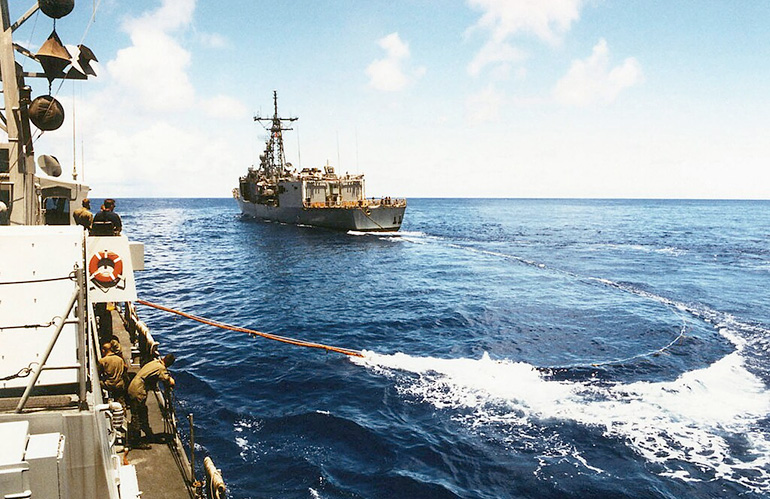
A view taken from onboard the US Navy (USN) Cyclone Class Coastal Defense Ship, USS HURRICANE (PC 3), showing a trailing refueling line being extended from the USN Oliver Hazard Perry Class: Guided Missile Frigate, USS JOHN H. SIDES. | Credit: US Navy
As the Navy expands its fleet of uncrewed surface vehicles (USV), Stratom has been selected for a Phase I Small Business Innovation Research contract to develop an autonomous refueling system that could redefine naval refueling and logistics at sea.
As the leading developer of autonomous vehicles and refueling robotic systems for logistics and operational applications, the contract will leverage Stratom’s Deployable Onboard Refueling Interface, or DORI, an automated system designed to let USVs refuel without human intervention.
Stratom was honored with an RBR50 in 2023 for RAPID, a portable autonomous refueling system designed to operate in extreme environments, such as a battlefield, to refuel aircraft or trucks. Mark Gordon, CEO of Stratom, appeared on episode 154 of The Robot Report Podcast, where he provides an update on Stratom’s roadmap.
“Autonomous refueling is truly a force multiplier — and the next step toward a fully autonomous maritime force,” said Gordon, “with DORI, we’re engineering a practical, scalable way for uncrewed vessels to stay on mission longer, without relying on vulnerable crewed interventions.”
Building upon existing naval refueling infrastructure while introducing targeted automation, Stratom’s DORI system integrates a hose retrieval system, perception sensors, an automated reel mechanism, and a quick-release coupling for emergency disconnects. By enabling USVs to safely and reliably refuel while underway without human intervention, the system will extend operational endurance, reduce personnel risk, and increase mission flexibility in contested or distributed environments.
The Phase I effort will validate the technical feasibility of the system’s automated reel mechanism and include concept refinement, small-scale prototyping, trade studies, and integration of commercial bunkering best practices. These activities will ensure the proposed method is technically feasible and aligned with operational requirements.
Looking ahead, Stratom also sees strong potential for commercial deployment of DORI in ship-to-ship (STS) bunkering, a key refueling process in commercial shipping and global maritime logistics. Automating STS bunkering could reduce high-traffic port congestion, improve safety, and cut operating costs for long-haul shipping fleets.
Stratom brings deep experience to the development effort, successfully transitioning robotic refueling systems developed for the Army and Navy into commercial applications. RAPID, the company’s autonomous refueling, recharging, and liquid transfer platform for robotic ground and aircraft refueling, proves the value of automating complex fueling operations through increased uptime, reduced labor demands, and enhanced safety.

US Navy Overlord USV Ranger umnanned vessel. | Credit: US Navy
The post Stratom awarded Navy contract for autonomous refueling system appeared first on The Robot Report.

